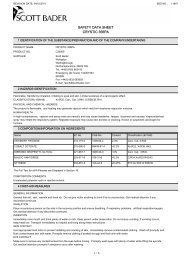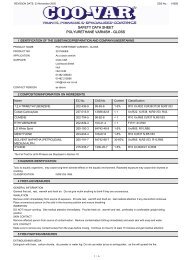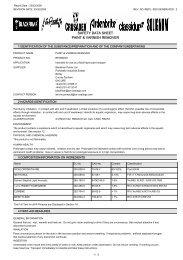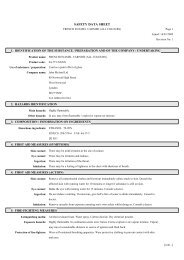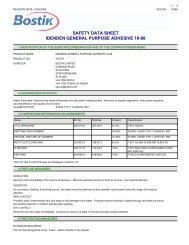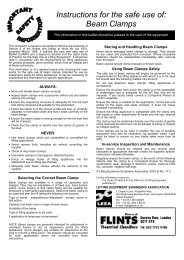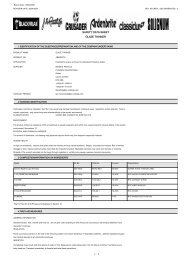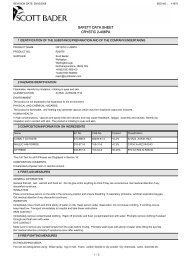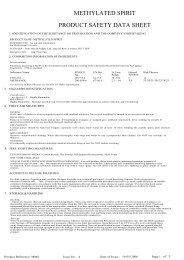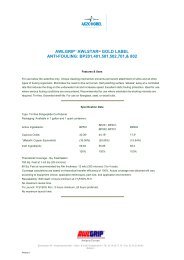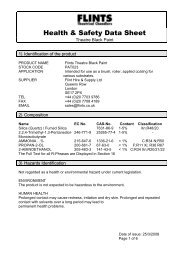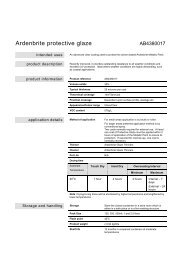safety data sheet nitromors all purpose paint & varnish remover
safety data sheet nitromors all purpose paint & varnish remover
safety data sheet nitromors all purpose paint & varnish remover
Create successful ePaper yourself
Turn your PDF publications into a flip-book with our unique Google optimized e-Paper software.
12110 - NITROMORS ALL PURPOSE PAINT & VARNISH<br />
REMOVER<br />
STABILITY:<br />
CONDITIONS TO AVOID:<br />
REVISION DATE:08-08-2002<br />
Norm<strong>all</strong>y stable. Will decompose on red hot surfaces, in electric arcs or naked flames<br />
to evolve predominately hydrochloric acid and a trace of phosgene gas<br />
Avoid heat. Avoid contact with oxidisers or reducing agents.<br />
HAZARDOUS DECOMP.<br />
PRODUCTS:<br />
Fire creates: Toxic gases/vapours/fumes of: Carbon monoxide (CO). Phosgene<br />
(COCl2). Hydrogen chloride (HCl).<br />
11. TOXICOLOGICAL INFORMATION:<br />
TOXIC DOSE - LD 50:<br />
HEALTH WARNINGS:<br />
OTHER HEALTH EFFECTS:<br />
ROUTE OF ENTRY:<br />
TARGET ORGANS:<br />
MEDICAL SYMPTOMS:<br />
MEDICAL CONSIDERATIONS:<br />
(dichloromethane) 1600 mg/kg (oral rat)<br />
Gas or vapour is harmful on prolonged exposure or in high concentration. This<br />
chemical may cause skin/eye irritation. CNS depressant. INHALATION. Solvent<br />
vapours are hazardous and may cause nausea, sickness and headaches. May cause<br />
irritation to the respiratory system. Narcotic effect. SKIN CONTACT. Irritating to skin.<br />
Acts as a defatting agent on skin. May cause cracking of skin, and eczema. EYE<br />
CONTACT. Irritating to eyes. INGESTION. Sw<strong>all</strong>owing concentrated chemical may<br />
cause severe internal injury. Liver and/or kidney damage. Unconsciousness, death.<br />
IARC Int. Agency for Cancer Research. Consolidated carcinogen list. Carcinogen<br />
Category 3.<br />
Inhalation. Skin absorption. Ingestion. Skin and/or eye contact.<br />
Central nervous system. Eyes. Heart & cardiovascular system. Kidneys. Liver.<br />
Respiratory system, lungs. Skin.<br />
Extreme irritation of eyes and mucous membranes, including burning and tearing.<br />
Dilated pupils. Severe skin irritation. Nausea, vomiting. Unconsciousness, possibly<br />
death. Central nervous system depression. Drowsiness, dizziness, disorientation,<br />
vertigo. Behavioral changes. Hypotension (low blood pressure).<br />
Skin disorders and <strong>all</strong>ergies. Liver and/or kidney problems. Convulsive disorders, CNS<br />
problems. History of smoking.<br />
12. ECOLOGICAL INFORMATION:<br />
LC 50, 96 HRS, FISH mg/l:<br />
ECOLOGICAL INFORMATION:<br />
MOBILITY:<br />
BIO ACCUMULATION:<br />
DEGRADABILITY:<br />
193-330 (dichloromethane)<br />
Dangerous for the environment if discharged into watercourses.<br />
Will sink in aqueous systems. Slighly soluble in water Will evaporate from land spillage.<br />
Not expected to bioaccmulate.<br />
Slowly biodegradable in water. Slowly biodegradable in soil.<br />
13. DISPOSAL CONSIDERATIONS:<br />
DISPOSAL METHODS:<br />
Vent to atmosphere. Dispose of in accordance with Local Authority requirements. Do<br />
not <strong>all</strong>ow runoff to sewer, waterway or ground.<br />
4/6




